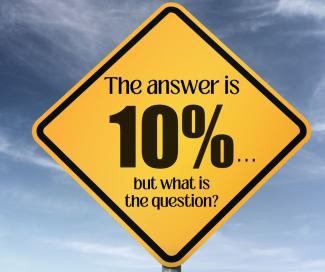
The Ultimate Answer Requires an Appropriate Question
by Gary Silverman, CFP®
In the great book that is both Science Fiction and English humor, The Hitchhiker’s Guide to the Galaxy, we find that the answer to the ultimate question is 42. The problem is, while the book’s characters had the ultimate answer, they didn’t know what the ultimate question was.
In the world of investing, it seems like the ultimate answer is 10%. What do stocks return? 10%. What withdrawal rate can my retirement portfolio support? 10%. How much do I need to save to be able to retire? 10%. The thing is, while 10% is the answer, those aren’t the questions.
For instance, do stocks return 10%? Well yes…sort of. If you are looking at the long-term return rate for stocks, you’ll get 10%. But if the question is: “I’m retiring in 10 years, what kind of return can I expect across that time, on average, if I invest in the stock market?” Well, then the answer to this question is not 10%. The answer is, “I don’t know.” If we had to put a number to “I don’t know” it would be around 0%. That’s right. Zero, nada, nothing.
In case you don’t remember, when the market was bottoming out in 2008 and 2009, the 10 years leading up to it had no return. Yes, the average for the last 100 years or so may be 10%, but you’ll have a decade here or there where the return is zero. Or worse.
When it comes to withdrawing money from your portfolio, 10% isn’t the right answer there, either. Okay, it is the right answer if you asked, “What is the most common guess people make as to how much they can withdraw from their portfolio on a sustained basis?” But it’s just that, a guess—and a wrong one. The studies that I give credence to come up with numbers in the 3.5-5.5% range. That’s a long way from the mythical 10%.
How about the last answer, the one about how much to save for retirement? Well, 10% is a good place to start for the question, “If I start saving for a retirement that starts in 40 years, how much do I need to save?” Assuming that you plan to retire around the age of 65 and you start saving by age 25 without interruption, 10% isn’t that bad of a number.
If you start in your 30s, you want to start around 15%. Wait until your 40s and this jumps to around 30%...daunting for many people. It’s a simple time-value money equation-- if you lack the time; you need to add more money.
Ten percent. Not a bad answer. But first, you must ensure you are answering the right question.

